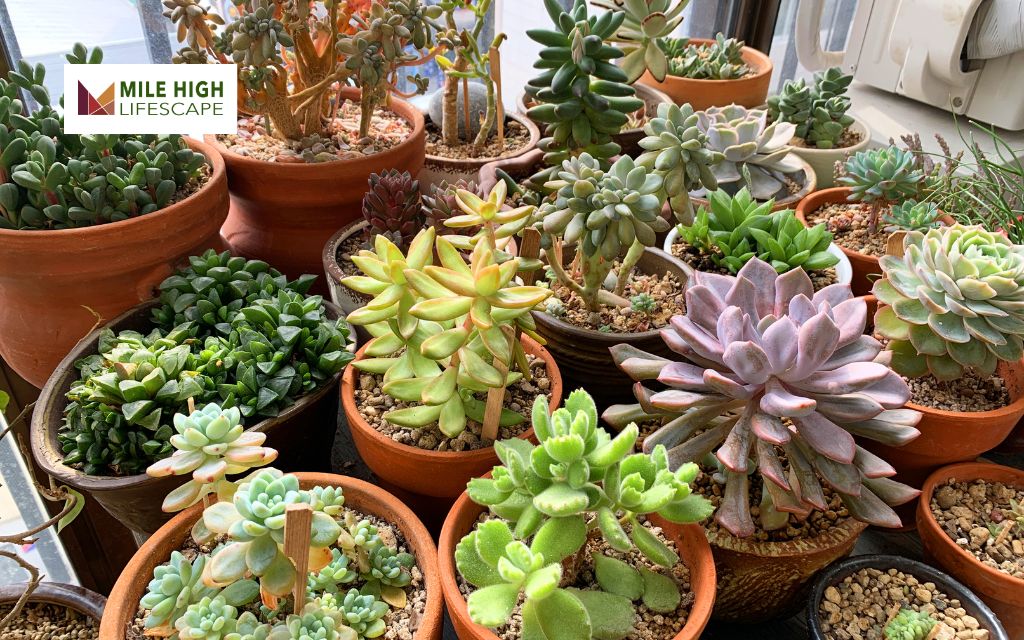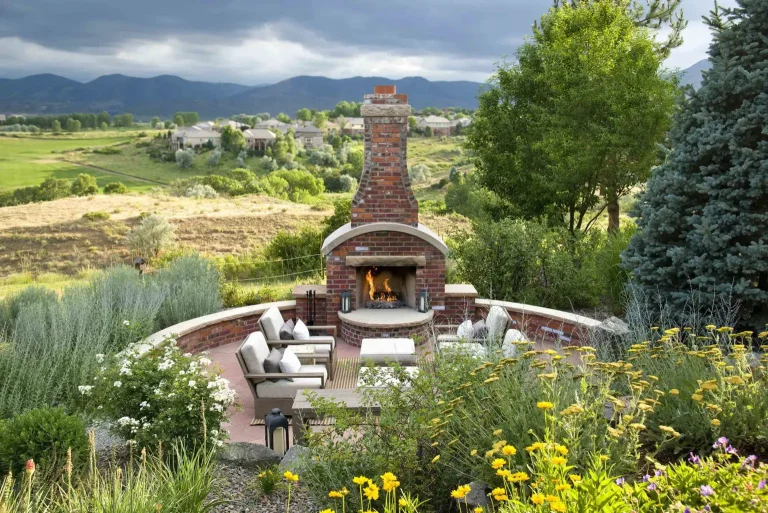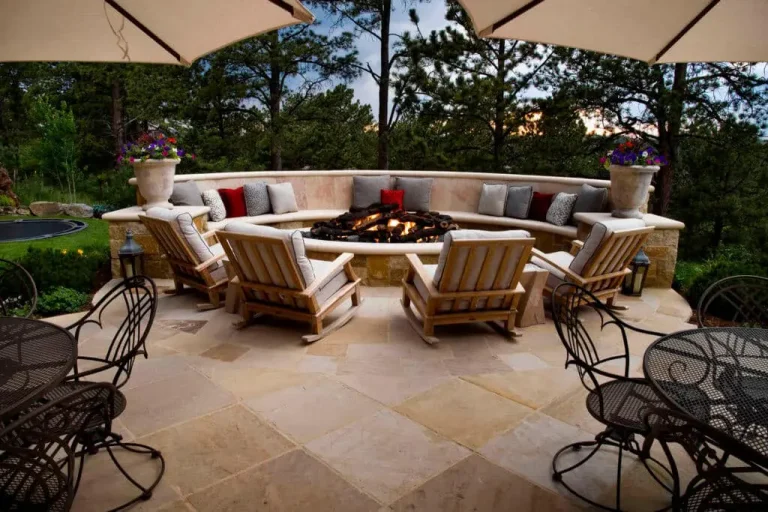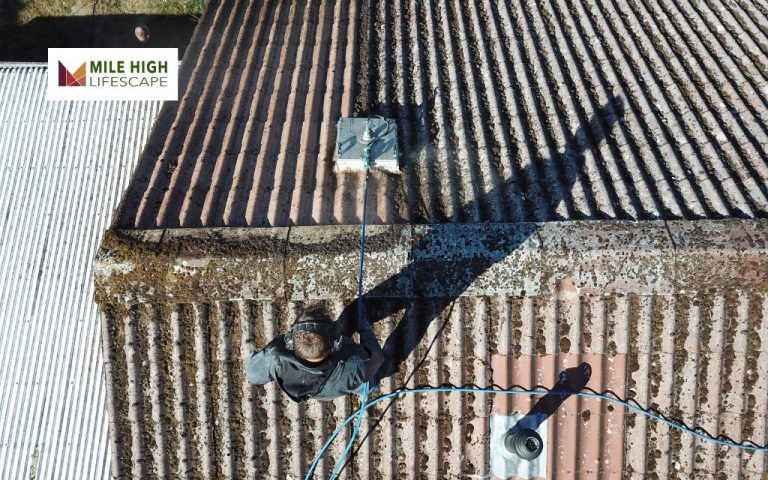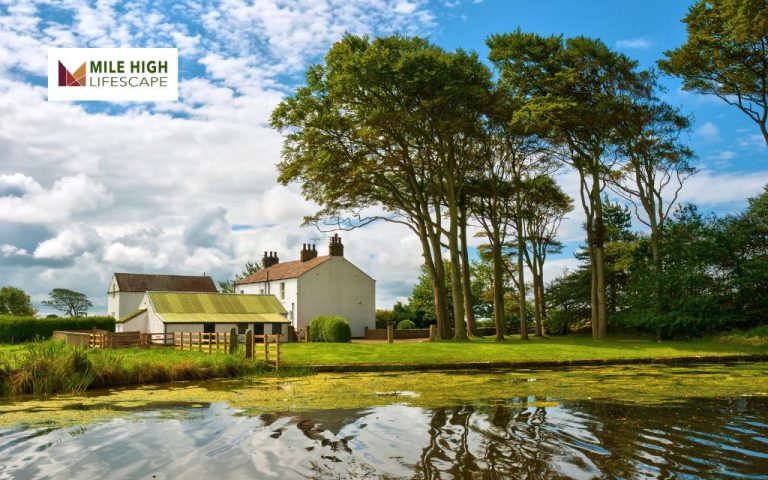Xeriscape landscape design is redefining outdoor spaces with its eco-friendly approach to landscaping. By focusing on water-efficient plants and sustainable practices, xeriscaping has become a popular choice for homeowners looking to conserve resources while maintaining a stunning yard.
The benefits of xeriscape landscape design are undeniable: it promotes water conservation, reduces maintenance efforts, and creates a unique, aesthetic appeal that stands out. For Denver homeowners ready to embrace this sustainable style, Mile High Lifescape is the trusted expert in designing and building custom xeriscape landscapes tailored to your yard’s specific needs.
Ready to combine beauty and sustainability in your outdoor space? Let’s dive into the possibilities of xeriscape landscape design!
What Is Xeriscape Landscape Design?
Xeriscape landscape design is a way of planning and creating gardens that use less water. The word “xeriscape” comes from the Greek word “xeros,” which means dry, and it focuses on using plants and materials that don’t need much extra water to grow. This method started in the 1980s by Denver Water in Colorado when they faced a serious drought. The idea was to reduce water use in yards and gardens.
Since then, xeriscaping has become very popular, especially in dry areas, because it helps save water. It started as a solution for places with water shortages, but now many homeowners, businesses, and cities use it. Xeriscape landscape design can be adjusted to fit different climates and looks, making it a smart and flexible way to conserve water in landscaping.
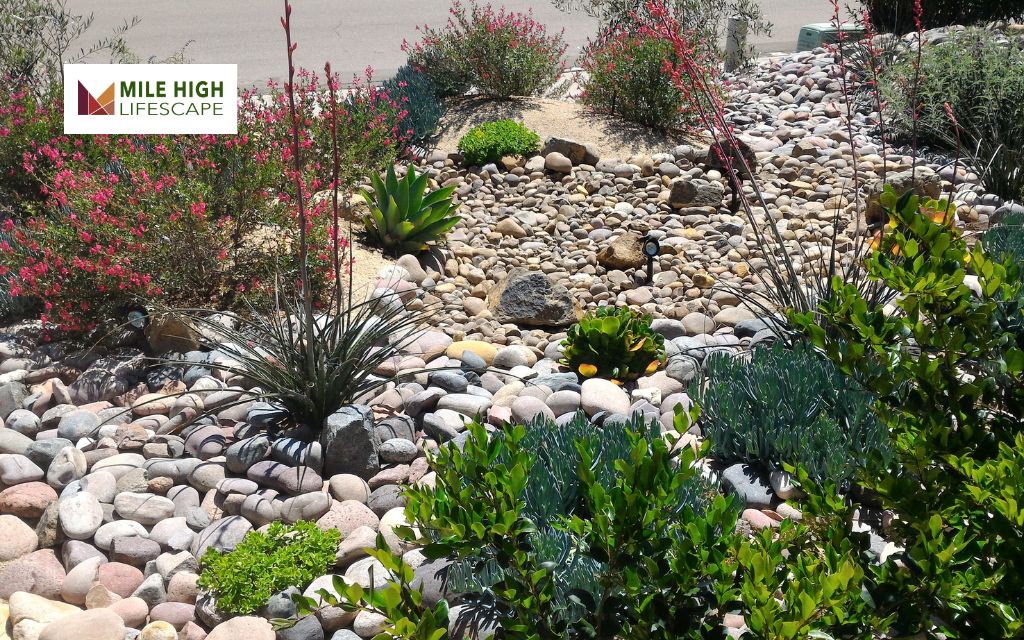
Benefits of Xeriscape Landscape
Saves Water
Xeriscape landscape design helps save water by using native plants, which are plants that are naturally suited to your area, climate, and soil. These plants don’t need much water, and some don’t need any extra water at all.
By grouping plants together based on how much water they need (called hydrozoning), you can make sure each plant gets just the right amount, avoiding overwatering or underwatering.
Saves Money
Xeriscaping can lower your water bill by up to 80%! Plus, by choosing native plants, you won’t need to spend money on gas for the lawn mower or fertilizers for grass. Xeriscaping can cut your lawn care costs by up to 87%.
With a good xeriscape design, you can keep grass in one area and water and care for it as needed, while the rest of your garden thrives with little to no extra costs. Native plants and rocks are much cheaper than sod or fake grass, making xeriscaping a budget-friendly option.
Saves Time
With xeriscaping, you won’t spend as much time watering, mowing, or weeding. Many drought-tolerant plants, like succulents and shrubs, only need water once every two to three weeks, and some native plants don’t need any water once they’re settled in.
While xeriscapes aren’t completely care-free, you can spend less time working in the yard. Most ground covers, like sage and sedum, only need occasional trimming, and using mulch or rocks will stop most weeds from growing. That means more time for fun!
Reduces or Gets Rid of Chemicals
Xeriscape landscape design uses native plants that are naturally suited to your area, so you won’t need to use fertilizers or pesticides. These plants are strong and know how to thrive in your soil and weather, which helps them resist pests and diseases.
Plus, rocks in your xeriscape design don’t need any chemical treatments. After all, you don’t need to fertilize rocks or spray herbicide on your gravel!
Saves Energy and Cuts Pollution
Using energy to treat water, run a lawn mower, or make fertilizers can harm the environment. Xeriscaping helps reduce energy use, meaning less fuel is burned, more water is saved, and fewer harmful chemicals go into your local water supply. This is a great way to help protect the planet while making your yard look beautiful.
Beautiful and Fun to Garden
Xeriscaping isn’t just good for the environment; it’s also a lot of fun! Many people love creating a xeriscape garden because it’s a peaceful place filled with flowers, butterflies, and interesting rocks. Designing a rock garden, building a cozy patio, or making a wildflower garden can be really enjoyable. Plus, it might even inspire your neighbors to start their own eco-friendly garden!
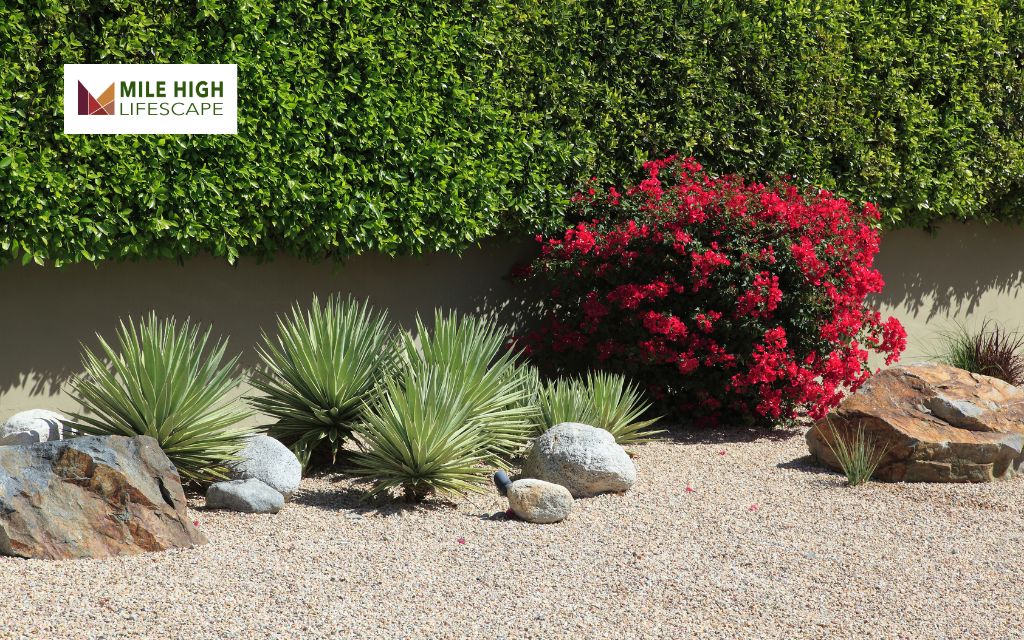
7 Front Yard Xeriscape Landscape Design Ideas to Inspire You
Design with Mulch
Mulch is a must in any xeriscape landscape design. It helps keep moisture in the soil and keeps it cool, which is super important for water-saving gardens. Putting down a layer of mulch—either organic or inorganic—does several things:
- It improves soil health and structure
- It keeps weeds from growing
- It makes your garden look polished and neat
There are different types of mulch you can choose from, like pine bark or crushed stones, each giving your garden a different look. Here’s how to pick:
- Stone mulch works great in rock gardens or around cacti and succulents.
- Gravel is a good choice for Mediterranean-style gardens with plants like lavender and rosemary.
- Shredded bark is perfect for gardens that have a cottage or English garden feel.
Xeriscape with Paver Walkways
If you’re looking for a fun and eco-friendly idea for your front yard, consider adding garden paths. They’re not just useful; they can also help conserve water. When you design your walkways right, they can collect rainwater and let it soak into the ground, which is great for your plants. Here’s how to do it:
- Skip solid concrete paths since they block water and create runoff.
- Use pavers with small gaps between them, so rain can reach the soil.
- Put the pavers on crushed stone to help the water flow through.
- Let small plants grow between the pavers to keep the soil moist.
If pavers are too pricey, gravel paths are a good, affordable option!
Low-Maintenance Rock Gardens
Rocks and boulders are great for xeriscape gardens because they help keep moisture in the soil. They also don’t require any maintenance. You can arrange big boulders together to create a beautiful focal point in your garden, then add plants around them.
Cacti, succulents, and drought-resistant herbs are perfect for rock gardens. You can also add wildflowers to give it some variety. For ground covers, try creeping thyme, lamium, creeping phlox, or campanula—they will grow beautifully in the small spaces between the rocks!
Enjoy Mediterranean Fragrances
The Mediterranean region is known for its hardy, drought-resistant herbs that thrive in full sun and well-drained soil. Some of the best options to include in your xeriscape landscape design are:
- Thyme
- Rosemary
- Oregano
- Lavender
These fragrant herbs can make your garden smell amazing, and they don’t cost much to grow.Lavender and rosemary have calming scents, while thyme and oregano attract bees and butterflies while keeping pests away.
Adding these herbs to your garden will create a beautiful and functional space that smells wonderful and adds flavors to your dishes. Perfect for anyone who loves cooking and nature!
Plant Succulents in Containers
Succulents are great for adding to your garden in containers. Unlike other plants, they don’t need a lot of water and can thrive in pots where the soil dries out faster. Some popular succulents for your xeriscape garden include:
- Cacti
- Agave
- Aloe
- Sedum
- Crassula
- Gasteria
Succulents in containers can add structure and interest to your garden, and they can help define different areas. They’re perfect for extending your garden onto your deck or porch, giving your space more charm without the hassle of high maintenance.
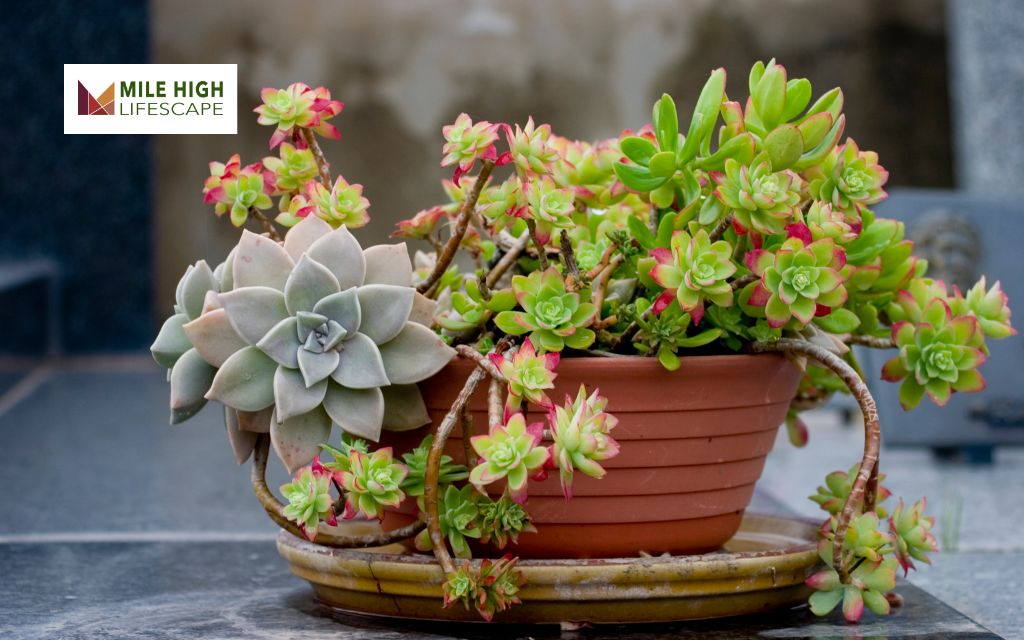
Get Creative with Xeriscaping Annuals
Annuals are plants that only last one year, but they add vibrant color to your garden. You can plant them in the spring, watch them grow, and enjoy their blooms in summer and fall. Some great annuals for a xeriscape garden include:
- African daisy
- California poppy
- French marigold
- Creeping zinnia
These plants give your garden a burst of color, and you can easily replace them next year for a fresh look!
Save Time with Perennials
Perennials are plants that come back year after year. Once you plant them and let them establish, they don’t need much care. Popular perennial grasses for xeriscaping include:
- Maiden grass
- Switchgrass
- Mexican feather grass
For wildflowers and shrubs, try:
- Russian sage
- Coneflower
- Shasta daisy
- Yarrow
- Verbena
- Blue false indigo
Plant them once, water them while they settle in, and trim them now and then. After that, these plants will grow back every spring, making your garden bloom year after year with little effort!
How to Plan Your Xeriscape Landscape Design
Core Principles
Xeriscape landscape design is based on seven main ideas that help save water and make your garden easier to care for:
- Use Drought-Tolerant Plants: Choose plants that are native or well-suited to your area, so they don’t need much water. These plants have naturally adapted to your region and can thrive with minimal watering once they’re settled in.
- Improve Soil Quality: Healthy soil holds water better and helps plants grow strong. Adding organic materials like compost can improve the soil’s ability to keep moisture, which helps reduce the need for extra watering.
- Efficient Irrigation: Use watering systems that are smart and waste less water. For example, drip irrigation and smart controllers water exactly where and when plants need it, saving water and money.
- Mulching: Applying mulch around your plants keeps the soil moist, reduces evaporation, and helps stop weeds from growing. It also makes your garden look nicer!
- Practical Turf Areas: Only plant grass where it’s really needed. By using drought-resistant grass and replacing unnecessary grass with ground covers or hard surfaces, you can save a lot of water.
- Group Plants by Water Needs: Put plants with similar watering needs together in “hydrozones.” This helps use water more efficiently because you water just the right amount for each group of plants.
- Low Maintenance: Design your landscape so that it needs less upkeep. This means fewer weeds, less fertilizer, and less water, giving you more time to relax and enjoy your garden.
How to Start Your Xeriscape Landscape Design
- Site Assessment: First, take a good look at your yard. Check the soil, how much sun it gets, and what plants are already there. Think about different areas, or “microclimates,” in your yard that may need special plants or different amounts of water. Also, look for spots where water doesn’t drain well, as they might need some attention.
- Water Audit: Find out how much water you’re currently using. This will help you set goals for saving water. Check if your sprinkler system is working efficiently, and think about adding a water meter for just your garden to keep track of how much you’re using.
- Design Concept: Next, imagine what you want your xeriscape to look like. Think about what works best for how you use your yard, like space for family gatherings or a relaxing garden area. Also, consider how your yard will look from inside your home and how it will change through the seasons.
- Budget Planning: Set a budget for your project. Consider both the upfront costs and how much money you’ll save in the long run with less water usage. Look into any local programs that might offer rebates for water-efficient landscaping, and if needed, break the project into smaller parts over time to fit your budget.
- Choose the Right Plants: Pick the right plants for your xeriscape to make sure it thrives. Choose native plants that are already used to your climate and need less water. Group plants with similar water needs together, which makes it easier to water them. Mix evergreen and deciduous plants to keep your garden looking great all year. Choose plants with different colors, textures, and shapes to make your garden more interesting, and be sure they’ll fit well as they grow.
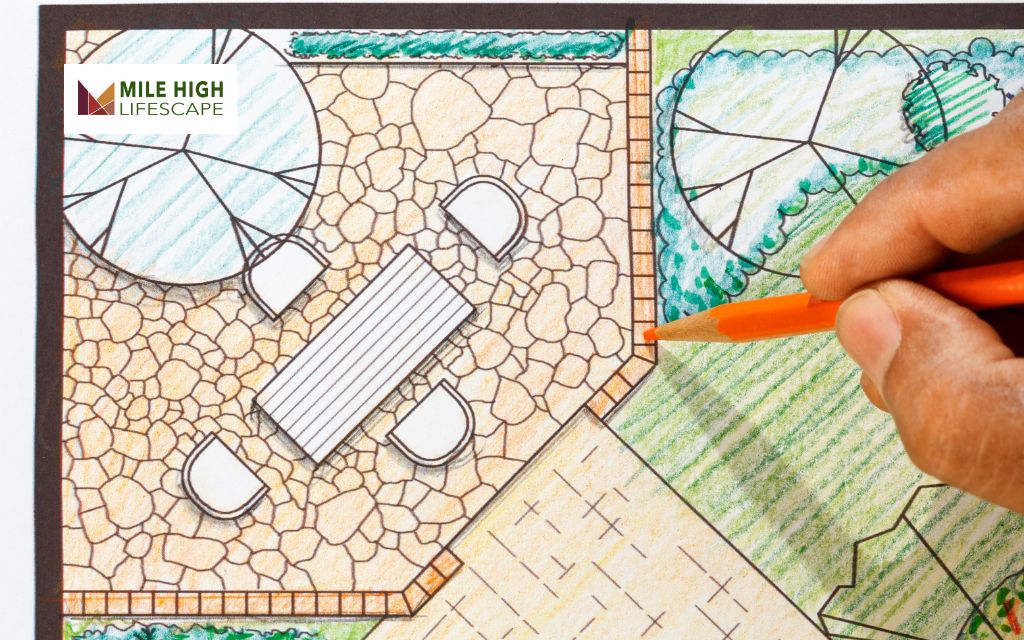
FAQs about Xeriscape Landscape Design
What is the best material for xeriscape?
In xeriscaping, materials like gravel, decomposed granite, and mulch are great choices. These materials help keep the soil moist, stop weeds from growing, and make your garden look beautiful. Adding drought-resistant plants and using smart irrigation systems also help your xeriscape landscape design stay healthy and efficient.
What are the 5 basic elements of landscape design?
The five key elements of landscape design are:
- Line: Guides where your eyes go and helps with the flow of movement in the yard.
- Form: The shapes of plants and structures that set the overall feel of the space.
- Texture: The feel of the surfaces of plants and materials, adding variety and interest.
- Color: Makes the space more visually exciting and sets the mood.
- Scale: Ensures everything in the landscape is the right size and fits together well.
What are the best xeriscape plants?
The best plants for xeriscaping are those that don’t need much water and fit well with the local climate. Some good examples are:
- Lavender: A fragrant herb with purple flowers that loves dry weather.
- Yarrow: A tough plant with feathery leaves and colorful flowers.
- Blue Grama Grass: A native grass that doesn’t need much water.
- Russian Sage: A bush with silver leaves and purple-blue flowers.
Choosing native plants is a great idea since they are naturally suited to your area and require less watering.
Where is xeriscaping best implemented?
Xeriscaping is perfect for dry places where water is hard to come by. But it can also work in other areas, helping to save water and make your landscape more eco-friendly. Using drought-tolerant plants and smart watering techniques helps create a beautiful, sustainable garden no matter where you live.
Conclusion
Xeriscape landscape design is a smart way to create a beautiful yard while saving water and reducing maintenance. By using native plants, mulch, and thoughtful layouts, you can enjoy an outdoor space that’s eco-friendly and easy to care for. Whether you want a vibrant garden or a peaceful retreat, xeriscaping makes it possible.
Mile High Lifescape specializes in custom xeriscape designs tailored to your needs, combining function and beauty. Ready to transform your yard into a stunning, sustainable haven? Let xeriscape landscape design bring your vision to life!
